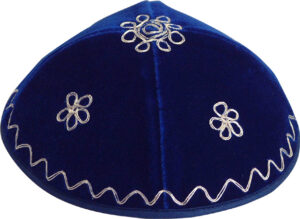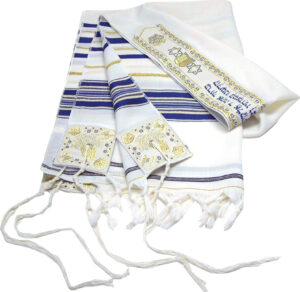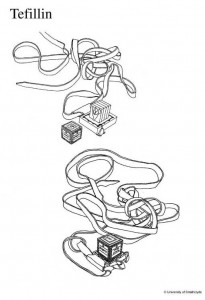Kippah/Yarmulke

www.jewsforjesus.org
First, let us take a quick look at the most well known symbol of Jewishness, the little skullcap worn by Jewish men. The skullcap is called a Yarmulke in Yiddish and a Kippah in Hebrew. The practice of wearing a Kippah varies to a great extent. Ultraorthodox and Orthodox Jewish men will wear a Kippah 24 hours a day, seven days a week. Among the less observant, the Kippah is only worn in the Synagogue, during prayer, or during meals. Some non-practicing Jewish men wear the Kippah for social reasons only, strictly as a sign of Jewish identity.
The custom of covering the head has found broad acceptance in the Jewish community today. The Orthodox and Conservative strands of Rabbinic Judaism believe that covering the head is an expression of reverence for God. Some view the Kippah as a reminder of God’s hand of blessing on the Jewish head. God is above blessing and protecting the Jewish person, but also evaluating the conduct of every individual.
Tallit

www.jewsforjesus.org
A Tallit is a prayer shawl of various sizes and materials. The Zitzit (fringes, tassels) were attached to each of its four corners. The origin of the Tallit is found in Num. 15:37-41. In the days of Moses, Jewish people wore four cornered garments on a day-to-day basis. The tassels were attached to the corners of everyday garments. As styles changed, the four cornered garments disappeared. Therefore, the rabbis created a four-cornered garment, the Tallit, for fulfilling the command of Num. 15:37-41. According to the passage, the tassels serve as a reminder to the Jewish person to obey the Mosaic Law and live a life dedicated to God because God delivered us out of slavery in Egypt. Today Tallitot (plural) come in a multitude of creative designs and colors. The Tallit is worn over the shoulders with the tassels in front and back so the wearer is surrounded by the fringes. Jewish men wear the Tallit during their times of prayer, at home, or in the Synagogue. Recently, Jewish women of other than orthodox practice have begun donning Tallitot as well.
Tefillin

www.strath.ac.uk
The word Tefillin is related to the Hebrew word for prayer, tefilah. Often the word is translated as “phylacteries.” Phylacteries is not an appropriate translation because that word means “an amulet.” Tefillin are not superstitious amulets. Instead, symbols were commanded to be created by the Mosaic Law to serve as reminders of the necessity to keep the commands of God in the head and in the heart. These directions were given in Exodus 13:9, 16, and Deuteronomy 6:8, 11:18.
Tefillin consist of little boxes bound to the head and arm with leather straps that contain the verses mentioned above. These boxes are bound to the head and arm during weekday morning prayer services. The arm box contains one piece of parchment on which the four passages of Scripture cited above are written. The box bound to the forehead contains four compartments. Each compartment contains one piece of parchment on which is written one of the four sections of Scripture mentioned above. Formerly it was customary to wear Tefillin all day. That is no longer the practice and they are removed at the end of the weekday morning prayer service.

